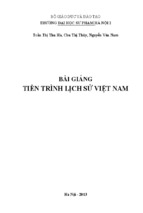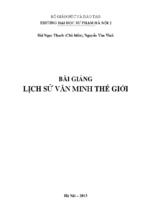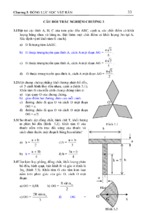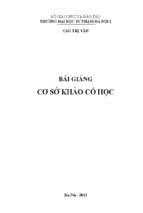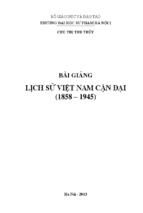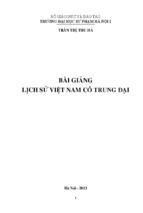Reflection, transmission spectrophotometry characterizes OLED materials
Đặc tính quang phổ phản xạ, truyền qua của các vật liệu OLED
An advanced metrology tool characterizes multilayer thin-fi lm OLED structures
based on power-spectral- density analysis of spectroscopic multiangle polarized
refl ection, polarized transmission, and spectro-scopic ellipsometric data.
Một dụng cụ đo cao cấp để xác định cấu trúc của OLED màng mỏng đa lớp dựa
trên việc phân tích mật độ phổ công suất của các dữ liệu phản xạ phân cực đa góc
quang phổ, truyền qua phân cực, và ellipsometry quang phổ.
The spectacular growth of the organic-light-emitting-device (OLED) industry over
the past couple of years has highlighted the technical challenges faced in the
manufac-turing of these devices. h e accuracy, repeat-ability, and uniformity of the
organic-layer thicknesses is a critical manufacturing issue for OLED displays
because these parameters directly af ect the brightness and color uniformity of
pixels in the display. Further-more, knowledge of the optical properties of the
organic layers is necessary for optimizing the design of the OLED display,
including the design of micro cavities, and in under-standing device properties
such as external light-coupling ei ciency. Rel ection and transmission
spectrophotometry is a fast, noncontact, and nondestructive character-ization
method that is ideally suited for these OLED manufacturing challenges.
Sự phát triển ngoạn mục của nghành công nghiệp thiết bị phát quang hữu cơ
(OLED) trong vài năm qua đã làm nổi lên các thách thức kĩ thuật phải đối mặt
trong việc sản xuất những thiết bị này. Độ chính xác, khả năng lặp lại và tính đồng
đều của chiều dày lớp hữu cơ là một tiêu chí sản xuất quan trọng của màn hình
OLED bởi vì các tham số này ảnh hưởng trực tiếp đến độ sáng và tính đồng đều
màu sắc của các pixel trong màn hình. Hơn nữa, các kiến thức về tính chất quang
học của các lớp hữu cơ là cần thiết để tối ưu hóa thiết kế của màn hình OLED, bao
gồm thiết kế các buồng cộng hưởng micro, và hiểu biết về tính chất thiết bị chẳng
hạn như hiệu suất ghép ánh sáng bên ngoài. Các phép đo phổ phản xạ và truyền
qua là phương pháp nhanh, không tiếp xúc, không phá hủy rất thích hợp cho các
thách thức trong việc chế tạo OLED.
Contending with OLED absorption
Đấu tranh với sự hấp thụ của OLED
Optical-metrology methods, including rel ect ometry and spectroscopic ellipsom
etry, have found widespread use in the silicon in-dustry for monitoring layer
thicknesses and optical constants (refrac-tive index n and extinc-tion coei cient k).
h ese techniques, however, have limitations when applied to OLED-related
applica-tions in which the organic i lms of interest tend to be thin and highly
absorbing in the UV range and are deposited on transpar-ent substrates. Although
rel ectometry (rel ec-tion spectrophotometry) methods can readily de-termine i lm
thickness (t) if the optical constants of the i lm are known (i xed), the technique
does not inherent-ly contain enough measured information to solve n, k, and t of
the i lm independently.
Các phương pháp đo quang học, bao gồm ellipsometry quang phổ và phép đo phản
xạ đã được sử dụng rộng rãi trong nghành công nghiệp silic để điều khiển chiều
dày lớp và các hằng số quang học (chiết suất n và hệ số tắt dần k). Tuy nhiên,
những kĩ thuật này có một số hạn chế khi áp dụng cho các ứng dụng liên quan tới
OLED trong đó các màng hữu cơ cần nghiên cứu mỏng và hấp thụ cao trong vùng
cực tím và được lắng tụ trên các đế trong suốt. Mặt dù các phương pháp đo phản xạ
(phép đo quang phổ phản xạ) có thể xác định được chiều dày màng (t) nếu đã biết
các hằng số quang học của màng (không đổi), hiểu nhiên, các kĩ thuật vốn dĩ
không chứa đủ thông tin để tìm n, k và t của màng một cách độc lập.
Spectroscopic ellipsometry, on the other hand, measures the polarization states of
collimated monochromatic light before and at er rel ection from a surface to obtain
the ratio of the complex p- and s-polarization rel ection coei cients and provides
twice as much information in the experimental data as does rel ectom-etry;
however, accurate determination of the extinction coei cient can be dii cult
without transmission data.
Mặt khác, elipsometry quang phổ đo trạng thái phân cực của ánh sáng đơn sắc
chuẩn trực trước và sau khi phản xạ từ một bề mặt để thu được tỉ số của các hệ số
phản xạ phân cực s và p phức và cung cấp nhiều thông tin dữ liệu thực nghiệm
nhiều hơn hai lần so với khi thực hiện phép đo phản xạ; tuy nhiên, việc xác định
chính xác hệ số tắt dần có thể khó khăn nếu không có dữ liệu truyền qua.
As a result, slightly more-involved analysis, such as the use of multiple sam-ple
data sets and/or determining thick-ness i rst in a nonabsorbing wavelength region,
may be necessary to arrive at a unique solution for n, k, and t. h e partial rel ection
from the backside of the trans-parent OLED substrate and the birefrin-gence of
some polymer OLED substrates (for example, polyethylene terephthalate i lms)
adds additional complexity to the collection and analysis of spectroscop-ic
ellipsometric data for OLED applica-tions. Although these two unknown ef-fects
can be incorporated in the optical model, they introduce uncertainty in the
uniqueness of the solution of the optical parameters.
Do đó, các phân tích phức tạp hơn, chẳng hạn như dùng các tập tập hợp dữ liệu
nhiều mẫu và trước hết xác định chiều dày trong vùng bước sóng không hấp thụ, là
cần thiết để đi đến nghiệm duy nhất của n, k, t. Phản xạ một phần từ mặt sau của đế
OLED trong suốt và tính lưỡng chiết của một số đế OLED polime (chẳng hạn, các
màng polyethylene terephthalate), làm tăng thêm tính phức tạp trong việc thu thập
và phân tích các dữ liệu elipsometry quang phổ cho các ứng dụng OLED. Mặc dù
hai hiệu ứng chưa biết có thể được tích hợp trong mô hình quang học, chúng đem
đến sự bất định trong tính duy nhất của nghiệm của các tham số quang học.
Alternatively, transmission spectro-photometry is an ideal technique for measuring
absorption and provides bet-ter resolution of the i lm’s extinction coei cient
compared with spectroscop-ic ellipsometry. Combining rel ection and transmission
spectrophotometry in a single instrument provides two data sets with enough
information content to uniquely determine the thickness and op-tical constants of
thin absorbing i lms on transparent substrates.
Thay vào đó, phép đo quang phổ truyền qua là một kĩ thuật lí tưởng để đo hệ số
hấp thụ và cho độ phân giải tốt hơn của hệ số tắt dần của màng so với phép đo
elipsometry. Kết hợp giữa phép đo phản xạ và truyền qua trong một dụng cụ cung
cấp hai tập hợp dữ liệu với hàm lượng thông tin đầy đủ để xác định duy nhất chiều
dày và các hằng số quang học của các màng mỏng hấp thụ trên đế trong suốt.
System design
Thiết kế hệ thống
We have developed advanced metrology tools based on a new optical technique
that uses power-spectral-density analy-sis of spectroscopic multiangle polarized rel
ection, polarized transmission, and spectroscopic ellipsometric data. For the
purpose of analyzing the OLED samples described here, we have limited our analysis to normal-incident spectroscopic re-l ection and transmission data. We have
found that this method allows for fast and accurate material analysis and thick-ness
determination of i lms during the production of OLED devices.
Chúng tôi đã phát triển các công cụ đo cao cấp dựa trên các kĩ thuật quang học mới
sử dụng phân tích mật độ phổ công suất của các dữ liệu phản xạ phân cực đa góc
quang phổ, truyền qua phân cực, và elipsometry quang phổ. Để phân tích các mẫu
OLED được mô tả ở đây, chúng tôi đã giới hạn ở việc phân tích dữ liệu truyền qua
và phản xạ tới vuông góc. Chúng tôi thấy rằng phương pháp này cho phép phân
tích nhanh và chính xác vật liệu và xác định chiều dày màng trong quá trình sản
xuất các thiết bị OLED.
The instrument (called the FilmTek 3000) used to measure and analyze the OLED
samples is a i ber-based system with a tungsten-deuterium light source and i xedgrating CCD- array spectrom-eters. Absolute rel ection and transmis-sion spectra
are obtained by collecting rel ection and transmission spectra from the sample of
interest in ratio to rel ection and transmission spectra from known samples (bare
silicon for rel ection and air for transmission). Rel ection and transmission spectra
can be measured from the deep-UV to near-IR, with ac-quisition time taking a
fraction of a sec-ond. Various optical coni gurations allow for a measurement spot
size that ranges from 3.5 mm to 2 µm.
Một dụng cụ (được gọi là Film Tek 3000) được sử dụng để đo và phân tích các
mẫu OLED là các hệ sợi quang với nguồn sáng tungsten-deuterium và các máy
quang phổ mảng CCD cách tử cố định. Phổ truyền qua và phản xạ tuyệt đối thu
được bằng cách thu phổ phản xạ và truyền qua từ mẫu đang nghiên cứu tỉ lệ với
phổ phản xạ và truyền qua từ các mẫu đã biết (silic trần để phản xạ và không khí
để truyền qua). Phổ phản xạ và truyền qua có thể được đo từ cực tím sâu đến hồng
ngoại gần, với thời gian thu nhận cỡ một phần giây. Các cấu hình quang học khác
nhau cho phép đo kích thướt vết từ 3.5 mm to 2 µm.
Accompanying sot ware simultane-ously solves for refractive index n(λ),
extinction coei cient k(λ), and thick-nesses of multilayer i lm structures. A selfconsistent solution is obtained by using a generalized dispersion formu-la
developed at Scientii c Computing International to model i tted values of the
dielectric function ε(λ) to the measured rel ection and transmission data. h e
dispersion formula is a self-consistent model that is derived from quantummechanical principles and correctly obeys the Kramer-Kronig re-lationship. It is
applicable to metallic, semiconductor, amorphous, crystal-line, dielectric, and
organic materials.
Kèm theo phần mềm giải đồng thời chiết suất n(λ), hệ số tắt k(λ), và chiều dày cấu
trúc màng đa lớp. Nghiệm tự hợp thu được bằng cách dùng công thức tán sắc tổng
quát hóa được phát triển tại Scientific Computing International để mô hình hóa các
giá trị được khớp của hàm điện môi ε(λ) của các dữ liệu phản xạ và truyền qua đo
được. Công thức tán sắc là mô hình tự hợp được rút ra từ các nguyên lí cơ học
lượng tử và tuân theo chính xác hệ thức Kramer-Kronig. Nó có thể áp dụng được
cho các vật liệu kim loại, bán dẫn, vô định hình, tinh thể, điện môi và hữu cơ.
By using a general dispersion model that covers the entire wavelength range of the
measurement, the number of vari-ables or parameters required to model optical
response is reduced, eliminating the potential for multiple solutions. h is approach
allows the user to model com-plex multilayer structures with rel ection and
transmission data. Global-optimiza- tion methods are used to obtain the best
solution while avoiding local minima and minimizing sensitivity to the user’s
initial guess of i tted parameters (for example, layer thickness). h e sot ware
optimizes the rel ection, transmission, and the pow-er-density-spectrum (fastFourier-trans-form) data simultaneously. h is allows for accurate thickness
determination over a wide range of thicknesses from 3 nm to 350 µm.
Bằng cách sử dụng mô hình tán sắc tổng quát bao phủ toàn bộ vùng bước sóng đo,
số biến hoặc các tham số cần thiết để mô hình hóa đáp ứng quang học được rút
giảm, hạn chế khả năng có nhiều nghiệm. Cách tiếp cận này cho phép người dùng
mô hình hóa các cấu trúc đa lớp phức tạp với các dữ liệu phản xạ và truyền qua.
Các phương pháp tối ưu toàn cục được sử dụng để thu được nghiệm tốt nhất trong
khi tránh được các cực tiểu cục bộ và cực tiểu hóa sự nhạy với dự đoán các tham
số khớp ban đầu của người dùng (chẳng hạn như chiều dày lớp). Phần mềm tối ưu
hóa đồng thời dữ liệu phản xạ, truyền qua và phổ mật độ công suất (chuyển đổi
Fourier nhanh). Điều này cho phép chính xác hóa việc xác định chiều dày trên một
khoảng chiều dày rộng từ 3 nm to 350 µm.
Application to OLED thin-fi lm structures
Ứng dụng của cấu trúc màng mỏng OLED
Light is produced in OLEDs when an appropriate volt-age is applied across the
electrodes, causing elec-trons and holes to recom-bine in the light-emission layer
(electroluminescence).h e most commonly used emitter material is tris (8hydroxyquinoline) alumi-num (Alq3). Changing the composition of the organic
layers tunes the OLED emission colors across the visible spectrum. For ex-ample,
by doping the Alq3 layer with other organic molecules, energy trans-fer from the
Alq3 to the dopant results in lower energy (redder) emission. Also, substantial shit
s in the electrolu-minescent wavelength can be achieved by controlling the number
and chemi-cal nature of the quinolate ligands in Alq3. With these approaches,
devices with electroluminescent emission in the red, green, and blue spectral regions have been demonstrated.
Ánh sáng được tạo ra trong các OLED khi một điện áp thích hợp được đặt vào các
điện cực, làm cho các electron và lổ trống tái hợp trong vùng phát xạ ánh sáng
(điện phát quang). Vật liệu emitter được dùng phổ biến nhất là tris nhôm (8hydroxyquinoline) (Alq3). Thay đổi thành phần của các lớp hữu cơ chuyển màu
phát xạ của OLED sang vùng phổ khả kiến. Ví dụ, bằng cách pha tạp vào lớp Alq 3
các phân tử hữu cơ khác, sự truyền năng lượng từ Alq 3 sang các tạp chất dẫn đến
sự phát xạ năng lượng thấp (đỏ hơn). Tương tự, các dịch chuyển quan trọng trong
bước sóng điện phát quang có thể đạt được bằng cách điều khiển số lượng và bản
chất hóa học của các phối tử quinolate trong Alq3. Với những cách tiếp cận này, các
thiết bị với sự phát xạ điện phát quang trong vùng phổ màu đỏ, xanh lá cây và xanh
da trời đã được báo cáo.
A typical OLED structure consists of organic layers grown on a glass or plas-tic
substrate to form a multilayer struc-ture about 1000 to 2000 Å thick (see Fig1).
Small-molecule OLEDs are deposited under vacuum by thermal sublimation,
while polymer-based OLED i lms are spin-coated and heat-treated. h e sub-strate is
i rst coated with a conduct-ing transparent electrode such as in-dium tin oxide
(ITO), which serves as the anode. h is layer is followed by a hole-transporting
layer (HTL) such as napthylphenylbiphenyl (NPB). An or-ganic light-emitting
layer (EML), such as doped Alq3, is then deposited on the HTL surface. A similar
material is ot en used for the electron-transporting layer (ETL) that is deposited on
the EML surface. h e device is completed by de-positing a low-work-function
metal cathode such as magnesium-silver alloy.
Cấu trúc OLED điễn hình bao gồm các lớp hữu cơ được phát triển trên đế thủy tinh
hoặc chất dẻo để hình thành cấu trúc đa lớp có chiều dày khoảng 1000 đến 2000 Å
(xem hình 1). Các OLED phân tử nhỏ được lắng tụ trong chân không bằng sự
thăng hoa nhiệt, trong khi đó các màng OLED polime được phủ quay và được
nung nhiệt. Trước hết đế được phủ với điện cực trong suốt dẫn điện chẳng hạn như
oxit thiết indi (ITO), đóng vai trò như a nốt. Tiếp theo sau là lớp vận chuyển lổ
trống (HTL) chẳng hạn như napthylphenylbiphenyl (NPB). Một lớp phát quang
hữu cơ (EML), chẳng hạn như được pha tạp Alq 3, sau đó được lắng tụ trên bề mặt
HTL. Vật liệu tương tự thường được sử dụng đối với lớp vận chuyển electron
(ETL) được lắng tụ trên đế EML. Thiết bị được hoàn thiện bằng cách lắng tụ một
ca tốt kim loại công thoát thấp chẳng hạn như hợp kim magiê – bạc.
h e optical properties of OLED mate-rials are essentially dependent on their
complex dielectric functions, which are related to the refractive index n and extinction coei cient k. h e nature and thickness of the organic layers in the OLED
structure can be optimized for ei cient charge migration, recombina-tion, and light
emission.
Về cơ bản, tính chất quang học của các vật liệu OLED phụ thuộc vào các hàm điện
môi phức của chúng, nó có liên quan đến chiết suất n và hệ số tắt dần k. Bản chất
và chiều dày của các lớp hữu cơ trong cấu trúc OLED có thể được tối ưu hóa theo
sự di chuyển điện tích, sự tái hợp, và phát xạ ánh sáng hiệu quả cao.
In routine use
Sử dụng thường xuyên
Rel ection and transmission spectropho-tometry is a powerful technique for characterizing the organic-i lm thicknesses and optical constants of multilayer OLED
thin-i lm structures. h e FilmTek 3000 is routinely used for the noncontact opti-cal
characterization of multilayer OLED structures on glass substrates. In one example, the rel ection and transmission spectra of single-layer OLED i lms on glass
are obtained from 240 to 1000 nm (Fig. 2). Analysis of the rel ection and transmission data gives accurate thickness values as well as the refractive index and extinction coei cients over the same wavelength range (see Fig. 3). h e layer
thicknesses of a multilayer OLED struc-ture on glass can also be de-termined
accurately and si-multaneously (see Fig. 4).
Phép đo quang phổ phản xạ và truyền qua là một kĩ thuật có hiệu lực để xác định
chiều dày màng hữu cơ và các hằng số quang học của các cấu trúc màng mỏng
OLED đa lớp. FilmTek 3000 được sử dụng thường xuyên để xác định đặc tính
quang học không tiếp xúc của các cấu trúc OLED đa lớp trên các đế thủy tinh. Ví
dụ như phổ phản xạ và truyền qua của các màng OLED đơn lớp trên thủy tinh thu
được từ 240 đến 1000 nm (Hình 2). Việc phân tích dữ liệu phản xạ và truyền qua
cung cấp giá trị chiều dày cũng như chiết suất và hệ số tắt dần chính xác trên cùng
một khoảng bước sóng (xem hình 3). Chiều dày lớp của cấu trúc OLED đa lớp trên
thủy tinh cũng có thể được xác định chính xác và đồng thời (xem hình 4).
When rel ection and transmission spectro-photometry is used for high-throughput
large-area l at-panel-display applica-tions, large custom stages and small
measurement-spot sizes allow the simul taneous determination of layer thicknesses
and optical properties—key performance metrics in the manufac-ture of OLEDs.
Khi các phép đo quang phổ phản xạ và truyền qua được sử dụng cho các ứng dụng
màng hình panel phẳng rộng công suất cao, các giai đoạn tùy biến lớn và kích
thướt vết đo nhỏ cho phép xác định đồng thời chiều dày lớp và các tính chất quang
học –các thang bậc hiệu năng quan trọng trong công nghệ sản xuất OLED.
- Xem thêm -


